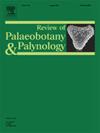岩洞孢粉学研究:岩洞内鸟粪沉积物的花粉含量不同吗?
IF 1.7
3区 地球科学
Q2 PALEONTOLOGY
引用次数: 0
摘要
在一些喀斯特地区形成的洞穴是发现蝙蝠鸟粪沉积物的重要场所,其中含有丰富而完好的花粉。这些鸟粪沉积物反映了该区域的植被特征,具有孢粉学重建古植被的潜力。然而,这种花粉积累发生的确切机制和影响它的因素尚不清楚。这项研究率先分析了来自年鸟粪积累的孢粉学数据,揭示了花粉在土耳其西北部洞穴中的分布方式。从洞穴的各个部分收集的鸟粪样本;其中,栎科、松科、松科、柏科/红豆科、Pistacia、Cuscuta、Silene、Fraxinus、Primula、Olea和Abies是鸟粪中的主要花粉成分。鸟粪样品中所代表的大部分分类群由属于风性植物的花粉粒组成;鸟粪中昆虫类群的花粉要比大气中丰富得多。洞内各采样站花粉总数的变化和花粉类型的差异具有统计学意义,说明洞内鸟粪中花粉的比例和分布存在差异。虽然洞穴鸟粪沉积物的孢粉学研究相当有限,但本研究强调需要改变对洞穴内采样模式的看法。因此,在这方面的进一步研究是必要的。本文章由计算机程序翻译,如有差异,请以英文原文为准。
A palynological perspective on a cave: Does pollen content differ in guano deposits within?
Caves formed in some karst regions are important places where bat guano deposits containing abundant and well-presented pollen can be found. These guano deposits reflect the regional vegetation and have the potential to contribute to the reconstruction of paleovegetation by palynology. However, the exact mechanisms by which this pollen accumulation occurs and which factors affect it are not yet clear. This study pioneers the analysis of palynological data derived from annual guano accumulation, shedding light on how pollen distribution may take place in the cave from NW Turkey. In guano samples collected from various parts of the cave; notably, Quercus, Pinus, Poaceae, Cupressaceae/Taxaceae, Pistacia, Cuscuta, Silene, Fraxinus, Primula, Olea, and Abies emerged as the primary pollen components in the guano. The majority of the taxa represented in guano samples consist of pollen grains belonging to anemophilous plants; however, pollen belonging to entomophilous taxa in guano were much more abundant than those found in the atmosphere. The observed variations in total numbers and statistically significant differences among pollen types between sampling stations in the cave indicate that pollen ratios and distributions in the guano differ within the cave. Although palynological studies in cave guano sediments are quite limited, this study emphasizes the need to change the perspective on the sampling pattern within the cave. Therefore, further research in this area is essential.
求助全文
通过发布文献求助,成功后即可免费获取论文全文。
去求助
来源期刊
CiteScore
3.50
自引率
21.10%
发文量
149
审稿时长
6 months
期刊介绍:
The Review of Palaeobotany and Palynology is an international journal for articles in all fields of palaeobotany and palynology dealing with all groups, ranging from marine palynomorphs to higher land plants. Original contributions and comprehensive review papers should appeal to an international audience. Typical topics include but are not restricted to systematics, evolution, palaeobiology, palaeoecology, biostratigraphy, biochronology, palaeoclimatology, paleogeography, taphonomy, palaeoenvironmental reconstructions, vegetation history, and practical applications of palaeobotany and palynology, e.g. in coal and petroleum geology and archaeology. The journal especially encourages the publication of articles in which palaeobotany and palynology are applied for solving fundamental geological and biological problems as well as innovative and interdisciplinary approaches.

 求助内容:
求助内容: 应助结果提醒方式:
应助结果提醒方式:


